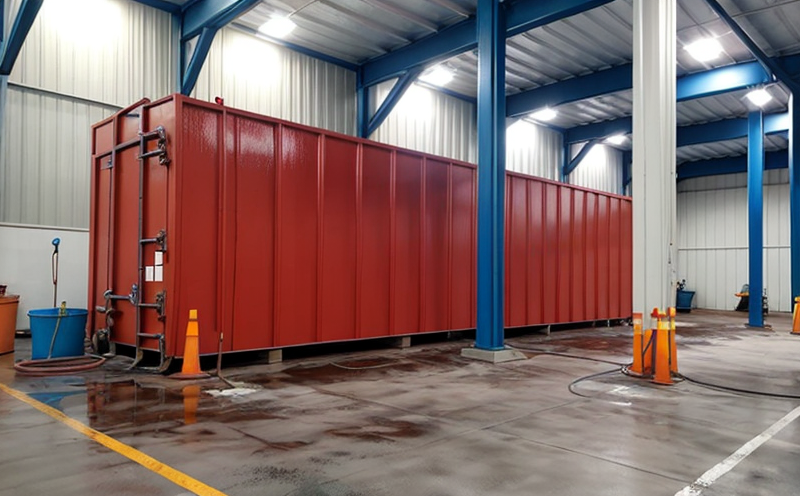ISO 1519 Mandrel Bend Flexibility Testing of Paint Films Validation Method Development Test
The ISO 1519 mandrel bend flexibility test is a critical procedure used to evaluate the mechanical properties of paint films, particularly their resistance to bending. This method is essential in industrial manufacturing and processing testing as it helps manufacturers ensure that coatings meet specified performance criteria, thereby enhancing product reliability and customer satisfaction.
The process involves applying a standardized force to a specimen cut from the painted surface using a mandrel (a metal rod) of specific dimensions. The bend angle at which the paint film cracks or fails is recorded as an indicator of its flexibility. This test is not just about determining whether the coating can withstand bending but also assessing how it behaves under stress, which is crucial for industries dealing with harsh environments.
The ISO 1519 standard specifies detailed procedures to ensure that tests are conducted consistently across different laboratories and locations. Compliance with this international standard guarantees accurate results and fosters trust within the industry. The test helps in validating new formulations or modifications made during research and development, ensuring they meet the required standards before being implemented.
The flexibility of paint films is vital for various applications such as automotive coatings, aerospace finishes, and industrial equipment protection. In these sectors, where environmental exposure can vary widely, understanding how a coating will perform under different conditions is crucial. The ISO 1519 test provides insights into the durability and longevity of a coating, which directly impacts maintenance costs and operational efficiency.
For quality managers and compliance officers, this test offers a clear pathway to ensure that products meet regulatory requirements without compromising on performance. R&D engineers benefit from precise data generated by ISO 1519 tests as it aids in refining formulations for better flexibility and adhesion properties. Procurement teams can use the results of these tests to make informed decisions about suppliers, ensuring they supply materials that not only comply with standards but also perform reliably under expected conditions.
During specimen preparation, care must be taken to ensure uniformity across samples. This includes selecting appropriate substrates and applying coatings in controlled environments to avoid external variables affecting the test outcome. Proper sample conditioning is essential for obtaining accurate measurements of flexibility.
Why It Matters
The ISO 1519 mandrel bend flexibility test plays a crucial role in industrial manufacturing and processing by providing data that reflects the real-world performance of paint films. In sectors like automotive, aerospace, and construction, where coatings are exposed to extreme conditions, this information is indispensable.
- Enhanced Product Reliability: By testing paint film flexibility according to ISO 1519 guidelines, manufacturers can ensure their products perform consistently under varied environmental conditions.
- Informed Decision-Making: Test results guide quality managers and R&D engineers in making decisions that improve product design and functionality.
- Regulatory Compliance: Adhering to international standards like ISO 1519 ensures compliance with relevant regulations, reducing the risk of non-conformance penalties.
The importance of this test extends beyond just laboratory settings; it influences how coatings are specified in contracts and specifies. The insights gained from these tests help create more robust specifications that account for expected stresses on materials.
Furthermore, the data obtained through ISO 1519 testing can be used to track trends over time, helping identify areas where improvements could lead to enhanced product performance. This continuous improvement cycle is vital for maintaining competitive advantage and customer satisfaction in highly regulated industries.
Quality and Reliability Assurance
- Consistency: The ISO 1519 test ensures that every batch of paint film tested follows the same procedure, leading to consistent results.
- Reduction in Waste: By identifying coatings that do not meet flexibility standards early on, manufacturers can reduce waste associated with rework or scrap.
The rigorous nature of ISO 1519 testing contributes significantly to quality assurance programs by providing reliable data used throughout the supply chain. From raw material selection to final product delivery, this test helps maintain high standards that contribute to overall reliability and customer satisfaction.
For industries reliant on coatings for protection against corrosion or wear, the ability to predict long-term performance based on ISO 1519 results is invaluable. This predictive capability allows manufacturers to design products that not only meet current demands but also anticipate future challenges related to environmental factors affecting paint film durability.
Customer Impact and Satisfaction
- Better Performance: Products that pass ISO 1519 tests are more likely to perform better over their intended lifespan, leading to higher customer satisfaction.
- Increased Trust: Compliance with international standards builds trust among customers who value reliability and quality.
Customers in sectors like automotive manufacturing or shipbuilding rely on coatings that can withstand rigorous conditions. Knowing that the products they purchase have been rigorously tested according to ISO 1519 instills confidence, fostering long-term relationships between suppliers and buyers.
The reliability provided by ISO 1519-compliant coatings translates into reduced maintenance costs for end-users. For instance, in cases where a coating fails prematurely due to insufficient flexibility, it can lead to costly repairs or replacements. By using tested materials that meet the required standards, companies can minimize such incidents, enhancing operational efficiency and reducing downtime.
Moreover, adherence to these testing protocols sets benchmarks against which competitors must strive. This competitive pressure encourages continuous innovation in coating technologies, ultimately benefiting consumers by offering better-performing products at reasonable prices.





